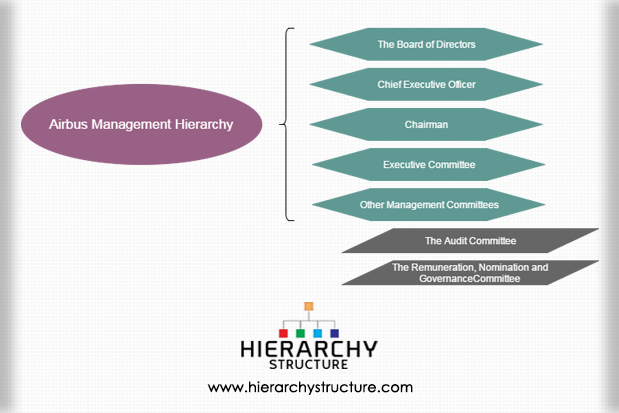The Airbus Group SE is a multinational company which originated in Europe. The European multinational works in the aerospace and defense domains and has it’s headquarter in Toulouse, France. The whole entity is divided into three distinct business management divisions namely- the Airbus, the Airbus Defense & Space, and the Airbus Helicopters. The management of the company has been restructured a number of times since its inception. The current Airbus management hierarchy as established by the heads is divided into the following categories:

The Board of Directors:
At the top of the management hierarchy is the board of directors. The board consists of a max of 12 members, and only the share/ equity holders can appoint or remove a member of the board. The board has an active role in the management of the company and also a crucial role in deciding the individuals who are appointed to different positions of importance in its management. The board of directors may also include equity holders, financers and shareholders etc.
The working and the functioning limit of the board of directors is governed by the Director’s Charter which lists in ample detail the duties and the rights of all the members of the board.
Chief Executive Officer:
The next in the management hierarchy of Airbus is the Chief Executive officer who is responsible for the operational efficiency and success of the company. The said CEO is directly answerable to the board of directors; the same board which appoints the CEO. The title for the position can also be expanded to include the president position i.e. the President and CEO of Airbus.
Chairman:
The next is the Chairman of the company, who is also appointed by the board.
Executive Committee:
The executive committee though second to the CEO, is one of the most important entities in the management of the company. The committee works in support of the CEO and help him in the fulfillment of day-to-day operations of the entity. The CEO is the chair for the committee and the members of the committee includes the heads of some of the major functional divisions of the group. Each committee holds the office for a period of five years.
Other Management Committees:
In addition to the board, the CEO and the Executive committee, two other committees are established for the management of the financial aspect of the company. These committees are, namely-
-
The Audit Committee:
The audit committee is established to analyze the organizations financial component and make recommendations to the Board about the annual financial statement and the approvals regarding the annual statements. As per rules, the committee has to meet 4 times a year, at least. The committee is responsible for many other factors like the appointment of external auditors, internal auditors, and remuneration determination etc.
-
The Remuneration, Nomination and Governance Committee:
The RNGC is set up to assist the Board in reference to the appointment of the members of the EC, the Company Secretary and the members of the Shareholder committee etc. The RNGC analyses different components (in reference to the appointments listed above) and makes recommendations based on the analyses to the Board.
